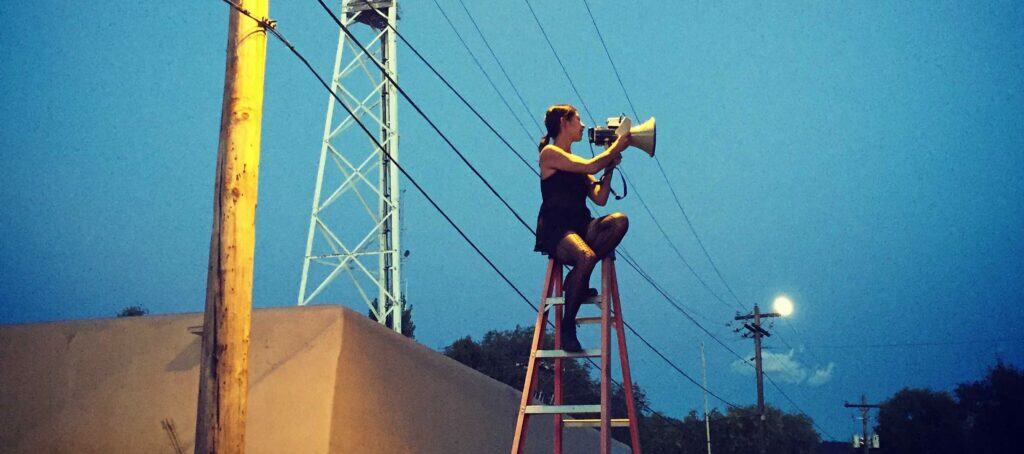Edie Tsong #FiftyQuestions
What artist do you consider most influential to your ongoing development as an artist?
My parents immersed us in the western visual arts. Mother’s decoupaged postcards of the paintings of Picasso throughout the house, then Max Waldman’s grainy black and white photographs of Nureyev, Natalia Makarova, and Gelsey Kirkland. I never saw myself in these images, only others.
We took piano lessons and played Bach Inventions, sonatinas by Clemente and Mozart. Music went straight into my body and bones, but as one of very few Asian Americans in my school, I did not want to be stereotyped, and sadly I quit piano. Many of these childhood songs that I played have stayed in my body.
Art felt like it belonged to other people and worlds. My freshman composition teacher (Thank you, Liz Mazzola) took us to see the Earth Room by Walter de Maria. I felt a direct somatic response to the dirt within the defined space. I smelled the earth, felt it’s humidity and weight, it’s sacredness — it asked that I only be human. Art became an outrageous possibility.
Patrick Callery (Thank you, dear friend) introduced me to the work of Rirkrit Tiravanjia — instant noodles being served from a canoe in a gallery. That made sense to me. My parents had crossed an ocean to get to the States, and, growing up, we ate instant noodles as a treat on Sundays! His projects were the inspiration to interact and engage with others, and an example of how to bring myself into what I do and make.
But even before all that, was being an infant in my mother’s arms under the dappled light of a tree. Sunlight, leaves, shadows, the sounds of voices and birds, the comfort of being held. Thinking that everything was floating and moving, and then seeing, it was still.
Describe your ideal workspace.
I didn’t believe in having a studio space. I thought the city, the environment would be my studio. Might I wander the streets and make casual and poetic work like Gabriel Orozco. Oranges in office windows, sticks leaning against a curb mimicking the NYC skyline. An orange in sunlight in the empty market in Mexico. I didn’t want a separation of life from art. That was so idealistic.
I didn’t afford a studio for a long time and had space only when I did residencies. When I had nowhere to think and be quiet and I stopped drawing. But I did find and direct a city-wide socially engaged project, Snow Poems. The project took over my little apartment, and sucked up my and my daughter’s lives.
Now I endeavor to have a studio and boundaries. A place to think and be free, unfettered. An ideal workspace would be spacious, large, with a windows looking out to nature. Expansive for ideas. For writing, I like a smaller space, a large table. Cozy and protected. Writing is so vulnerable. Sometimes a noisy cafe is a good place to write. But in any case, natural light is important, windows are important, the light, because sunlight moving across a room reminds me that everything is changing, everything is cyclical, and everything is magic.
What project of yours do you personally consider your most satisfying, and why – regardless of external support or accolades?
One of my most satisfying projects has been Love Letter to the World, a collaboration with Michael Lorenzo Lopez and many writers and participants. We did this project at the PASEO in Taos in 2015. We created a little writing station in Michaels’s camper where local writers helped festival participants type out a love letter to the person of their choosing. I would take these letters to the top of a 12’ ladder and read them from a bullhorn to the people below.
People wrote letters to crushes, long lost lovers, lifetime partners, unrequited loves. Parents wrote apologies to their children, children to parents. People wrote letters to their past selves and future selves. Carbon copies of the letters were displayed on the side of the camper, and the originals went home with the participants. In the reading I was a conduit. The longing, hurt, regret, and care embedded in the letters went through my body out to the world, and there was a feeling of deep sharing and tenderness for those who participated, shared, facilitated writing of, and those who listened. It was exhilarating. This loose and casual gathering of strangers happened right on street level.
When does Joy tend to visit you?
Joy visits in small and often quiet moments. Times when I’m alone: sunlight on my face, snow lofting down, the sound of the river, the sunset. Times with others: roasting a chicken to be eaten by friends/family, an unexpected connection with a stranger, an unexpected combination of words, coming to unity when playing music, connection, holding someone’s hand, hugging my daughter good morning and good night.
What surprises you most about what you are doing right now in your practice? If the nine-year-old you could see you right now, what do you think they would think?
It surprises and delights me that the love of music that my parents passed down to my sisters and I, has brought me back to sound/music, experimental and improvisational, at that! The nine-year-old would be so surprised at the wide range of possibilities and depth of expression of the arts that she did not know were possible. She would be surprised at the potency and necessity of the arts.
It surprises me that what my parents, with their scientific minds, could not give in emotional support, they gave through a love of the arts. The arts have shown me the entire range of human emotion, shown me joy and connection, and supported me through the darkest moments.
About Edie Tsong
Edie Tsong (Taiwanese American) is an interdisciplinary artist/writer. She has exhibited at the Mattress Factory, Yerba Buena Center for the Arts, Aspen Art Museum, 516 Arts, Babel Kunst, and participated in The PASEO and PICA’s TBA Fest. She is the recipient of the Lilla Jewel Foundation grant and the SPREAD 3.0 SITE Santa Fe grant. She was the Founding Director of Cut+Paste Society, women writers and artists in Santa Fe (2009 – 2015) and their city-wide Snow Poems Project (2011 – 2018). She is a VONA alumna and the Southwest regional chair of Kundiman, AAPI writers. Tsong lives and works in northern New Mexico with her daughter.

